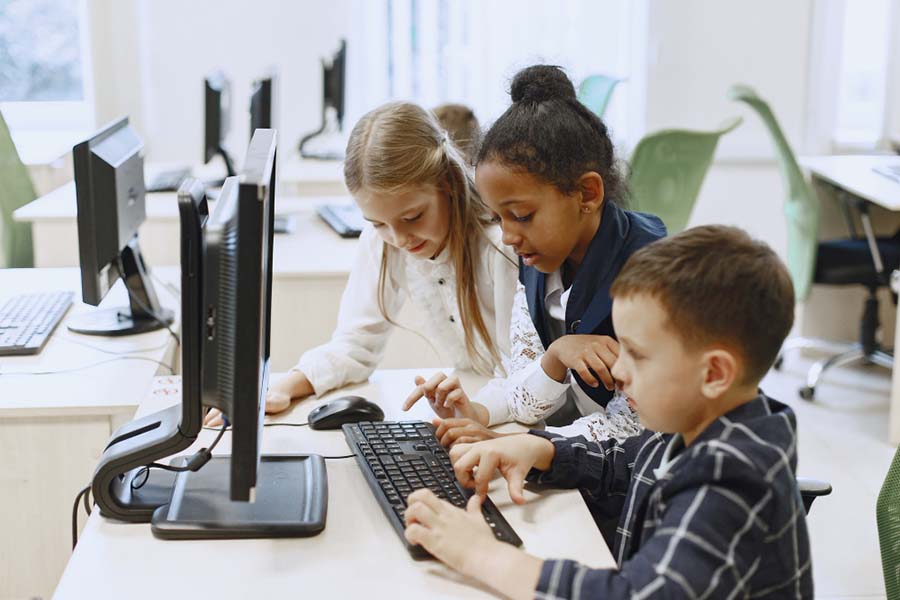Tech’s Impact on Education: Shaping Future Learning

Technology has become an integral part of our daily lives in today’s rapidly evolving world. It has not only transformed how we communicate and conduct business but has also revolutionised the field of education. Technology integration in education has opened up endless possibilities, empowering students and teachers in learning. In this blog, we will explore the role of technology in education and its effects on the future of learning.
Advancements in Educational Technology
Over the past decade, educational technology has experienced significant advancements, transforming the traditional classroom setting into a digital and interactive learning environment. These technological tools and platforms have made learning more engaging, accessible, and personalised.
Digital Learning Platforms
Digital learning platforms have revolutionised the way educational content is delivered and consumed. These platforms provide students access to many resources, including e-books, videos, interactive quizzes, and simulations. They offer a flexible learning experience, allowing students to learn independently and revisit concepts as needed.
Digital learning platforms also provide opportunities for teachers to customise their lessons and tailor them to the specific needs of their students. Educators can create a more dynamic and interactive learning environment by incorporating multimedia elements and interactive activities. This enhances student engagement and promotes active learning and knowledge retention.
Virtual Reality (VR) and Augmented Reality (AR)
Virtual Reality (VR) and Augmented Reality (AR) technologies have brought immersive experiences into the classroom. With VR, students can explore historical sites, dive into the depths of the ocean, or even travel to outer space, all within the confines of their classroom. This level of immersion enhances students’ understanding and retention of complex concepts by providing them with real-world context and experiences.
AR, on the other hand, overlays digital information in the real world, making abstract concepts tangible and easy to understand. For example, students studying anatomy can use AR to visualise and interact with 3D models of the human body, gaining a deeper understanding of its structure and functions. These technologies make learning more engaging and foster curiosity and a sense of wonder among students.
Online Collaboration Tools
Technology has facilitated collaboration among students and teachers, regardless of their geographical locations. Online collaboration tools allow students to collaborate on group projects, share ideas, and provide real-time feedback. This promotes teamwork, communication skills, and a sense of community, even in virtual classrooms.
Collaboration tools also enable students to engage in peer learning, where they can exchange knowledge, perspectives, and experiences. This collaborative learning approach encourages active participation and critical thinking as students learn from each other and challenge their own ideas. Additionally, online collaboration tools provide a platform for teachers to facilitate discussions and provide guidance, creating a supportive and interactive learning environment.
Adaptive Learning Systems
Adaptive learning systems utilise artificial intelligence to personalise the learning experience based on each student’s individual needs and abilities. These systems analyse student performance data, identify improvement areas, and provide tailored content and assignments. Adaptive learning enhances student engagement and helps them achieve better academic outcomes.
Adaptive learning systems ensure that students receive targeted instruction and support by adapting the learning materials and pace to each student’s strengths and weaknesses. This personalised approach to education maximises students’ learning potential and boosts their confidence and motivation. Additionally, adaptive learning systems provide teachers valuable insights into their students’ progress, enabling them to make informed instructional decisions and provide timely interventions.
Benefits of Technology in Education
Integrating technology in education offers numerous benefits, transforming how students learn and teachers teach. Some of the key advantages include:
Enhanced Engagement and Motivation
Technology provides interactive and engaging learning experiences that captivate students’ attention and foster their motivation to learn. The use of multimedia elements, such as videos and interactive games, makes learning more enjoyable and memorable. Additionally, technology allows for personalised feedback and immediate assessment, which helps students track their progress and stay motivated to achieve their learning goals.
Personalised Learning
Technology enables personalised learning experiences, catering to each student’s diverse needs and learning styles. As mentioned earlier, adaptive learning systems ensure that students receive content and assignments tailored to their strengths and weaknesses. This personalised approach allows students to learn at their own pace, focus on areas that require more attention, and explore their interests.
Personalised learning also promotes student autonomy and self-directed learning, as students have more control over their learning journey. By providing students with choices and opportunities to explore their unique interests and passions, technology empowers them to take ownership of their education and become active participants in the learning process.
Access to a Wealth of Information
The internet has become a vast knowledge repository, providing students access to information at their fingertips. They can conduct research, explore different perspectives, and stay updated on the latest developments in their fields of interest. This access to information broadens their horizons and helps them develop critical thinking and problem-solving skills.
Technology also enables students to connect with experts, professionals, and educators from around the world, expanding their learning networks and exposing them to diverse perspectives. Through online platforms, students can participate in virtual conferences, webinars, and discussions, gaining insights from industry leaders and subject matter experts. This exposure to a global learning community fosters a sense of curiosity, open-mindedness, and cultural awareness.
Improved Collaboration and Communication
Technology facilitates collaboration and communication among students, teachers, and experts worldwide. Online platforms and tools enable seamless communication, fostering the exchange of ideas, feedback, and knowledge-sharing. This enhances teamwork skills and prepares students for the collaborative nature of the modern workplace.
Collaborative learning strengthens students’ understanding of the subject matter and develops their interpersonal and communication skills. Through online discussions, group projects, and collaborative problem-solving activities, students learn to work effectively in teams, listen to different perspectives, and articulate their ideas clearly. These skills are essential in the 21st-century workforce, where collaboration and effective communication are highly valued.
Global Learning Opportunities
With technology, geographical barriers are no longer limitations to learning. Students can connect with peers and educators from different countries, gaining exposure to diverse perspectives and cultures. This global learning experience nurtures open-mindedness, empathy, and intercultural competence.
Technology allows for virtual exchange programs, where students can engage in cross-cultural collaborations, share their experiences, and learn from each other’s unique backgrounds. This exposure to different cultures and perspectives helps students develop a global mindset, preparing them to thrive in a multicultural and interconnected world. Additionally, technology enables students to explore global issues and challenges, fostering their sense of social responsibility and global citizenship.
The Future of Learning with Technology
As technology advances, its impact on education is expected to grow even further. The future of learning with technology holds great promise and potential for transformative education. Here are some key trends that will shape the future of learning:
Artificial Intelligence (AI) and Machine Learning
Artificial Intelligence (AI) and Machine Learning algorithms have the potential to revolutionise education. These technologies can analyse vast data, identify learning patterns, and provide personalised content and recommendations. AI-powered virtual tutors and assistants can support students, answer their questions, and provide timely feedback.
With AI, educators can gain deeper insights into students’ learning needs and adapt their instruction accordingly. AI algorithms can identify gaps in students’ knowledge, recommend targeted resources, and provide real-time feedback on their progress. This personalised and adaptive learning approach maximises students’ learning outcomes and ensures that they receive the support they need to succeed.
Internet of Things (IoT) in Education
The Internet of Things (IoT) can transform classrooms into intelligent learning environments. IoT devices like smartboards, wearable devices, and sensors can collect data on students’ behaviour, engagement, and learning progress. This data can then be used to personalise learning experiences, identify areas of improvement, and enhance educational outcomes.
For example, wearable devices can track students’ physical activity levels and sleep patterns, providing insights into their overall well-being and its impact on their learning. Smartboards with sensors can capture students’ interactions and engagement during lessons, helping teachers identify areas where additional support may be needed. By leveraging IoT technologies, educators can gain valuable insights into students’ learning processes and create more effective and engaging learning experiences.
Blockchain for Credentials and Certificates
Blockchain technology can provide secure and tamper-proof verification of educational credentials and certificates. This decentralised system ensures the authenticity of qualifications, making it easier for employers and educational institutions to verify the qualifications of individuals. Blockchain can also facilitate recognising prior learning, enabling seamless transitions between educational institutions and the workforce.
By leveraging blockchain, individuals can have more control over their credentials and share them securely with potential employers or educational institutions. This eliminates the need for time-consuming and costly verification processes, streamlining the hiring and admissions processes. Additionally, blockchain can enable individuals to showcase their skills and achievements transparently and verifiably, enhancing their employability and career prospects.
Gamification and Immersive Experiences
Gamification elements, such as badges, leaderboards, and rewards, can motivate students and make learning more enjoyable. Immersive technologies, like Virtual Reality (VR) and Augmented Reality (AR), will become even more prevalent, enabling students to explore realistic simulations and engage in hands-on learning experiences.
Gamification fosters a sense of competition, achievement, and intrinsic motivation among students. By incorporating game-like elements into educational activities, students are incentivised to participate and strive for excellence actively. Immersive technologies like VR and AR provide students with experiential learning opportunities beyond traditional textbooks and lectures. These technologies allow students to interact with virtual objects, experiment with different scenarios, and develop practical skills in a safe and controlled environment.
Lifelong Learning and Microlearning
Technology will continue to empower individuals to engage in lifelong learning. Microlearning, which delivers educational content in bite-sized and easily digestible formats, will become increasingly popular. This approach allows individuals to acquire new skills and knowledge at their own pace, fitting learning into their busy schedules.
Microlearning caters to the modern learner’s need for flexibility and efficiency. By breaking down complex concepts into smaller modules, individuals can focus on specific topics of interest or fill gaps in their knowledge. With the rise of mobile devices and online learning platforms, microlearning can be accessed anytime and anywhere, making learning more accessible and convenient. Technology-enabled lifelong learning ensures that individuals can continuously update their skills and adapt to the evolving demands of the workforce.
Conclusion
The role of technology in education is transformative. It enhances engagement, personalisation, collaboration, and access to information, preparing students for the challenges and opportunities of the future. As technology continues to evolve, its effects on the future of learning are bound to be even more profound, fostering innovation and empowering learners worldwide.
If you found this post engaging, don’t forget to explore our additional blogs:
- Enhancing User Experience: Dewalist Classifieds’ Commitment to Efficient Content Moderation
- Dewalist Soars to New Heights: A December 2023 Recap
- Dewalist Reaches 103 Users per Minute: A Google Analytics Record
- The Wealth of Nations by Adam Smith: A Word Book Summary
- Embracing Remote Work: Shaping Tomorrow’s Workplace
- Navigating Mental Health in the Justice System
- Social Media’s Relationship Impact: A Digital Paradox
- Embracing Diversity: Building Inclusive Workplace & Society
- Introducing Our New and Improved Dewalist Marketplace Design
- The Homelessness Epidemic: Unraveling the Housing Crisis
Sign up for updates on this blog and our latest posts if you enjoyed reading this one.
Help your friends and colleagues stay informed about the newest insights on business, marketing, finance, lifestyle, and society by sharing our blog content through Facebook, Twitter, Pinterest, LinkedIn, email, or WhatsApp links below. We can create a knowledge-sharing community and empower one another to accomplish and experience our objectives.
FAQ
How has technology transformed the traditional classroom setting?
Technology has transformed the traditional classroom by creating a digital and interactive learning environment, providing access to a vast array of resources, and allowing for personalised learning experiences.
What are some examples of immersive technologies in education?
Virtual Reality (VR) and Augmented Reality (AR) are examples of immersive technologies in education. VR allows students to explore virtual environments, while AR overlays digital information onto the real world.
How does technology facilitate collaboration among students and teachers?
Technology facilitates collaboration among students and teachers through online collaboration tools. These tools allow for real-time communication, group projects, and peer learning, creating a supportive and interactive learning environment.
What are the benefits of technology in education?
The benefits of technology in education include enhanced engagement and motivation, personalised learning experiences, access to a wealth of information, improved collaboration and communication skills, and global learning opportunities.
Credits
Featured image by prostooleh on Freepik.









